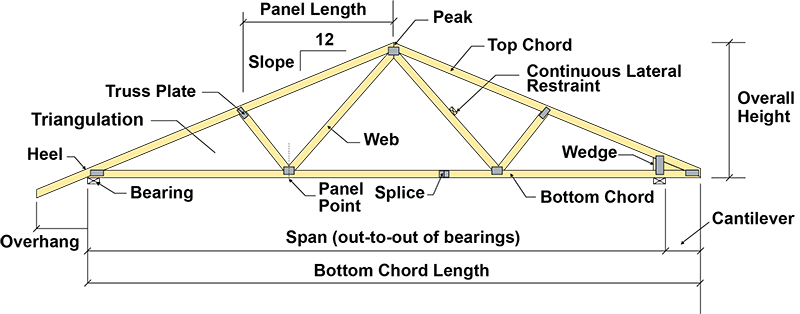The important point to keep in mind when you use your truss calculator is that every truss calculation is completely unique and is based on the size of your roof and its specific dimensions.
Roof and truss point loads.
Trusses are designed to carry two types of loads.
Live loads and dead loads.
Both sides of the equation should be equal in order to end up with a stable and secure roof structure.
This is a very god assumption because as we have seen earlier while introducing a truss triangle with pin joint the load is transferred on to other member of the trusses so that forces remain essentially collinear with the member.
A dead load is carried constantly by the truss.
The portion of the roof contained between successive trusses is called a bay.
Roofs are under a lot of pressure.
If the number of members is labeled m and the number of nodes is labeled n this can be written as m 3 2 n.
A live load is a temporary load that puts stress on the structure.
In order to stay intact and in place a roof must be able to resist loads both permanent and temporary that are pushing.
The member spanning from truss to truss which is meant to carry the load of the roofing material and to transfer it on the panel points is called a purlin.
The truss is a framework consisting of rafters posts and struts which supports your roof.
Trusses are typically modelled in triangular shapes built up of diagonal members vertical members and horizontal members.
While this article focuses on configurations we also have a very cool set of illustrations showcasing the different parts anatomy of roof trusses.
1 how to draw floor plan by hand.
How to calculate dead load on a roof truss per panel point with detailed figures.
The distance in this case is 12 ft 2 ft 14 ft.
Live loads include wind precipitation foot traffic and all other weight that comes and goes.
The formula for truss loads states that the number of truss members plus three must equal the twice the number of nodes.
Load limits on the roof of a building.
If the middle line of the members of a truss meet at a point that point is taken as a pin joint.
Simply add nodes members and supports to set up your model apply up to 5 point loads distributed loads can be added in full version then click solve to run the static 2d truss analysis.
The exterior wall and the headers within will carry all loads from the mid point of the house between the supporting walls to the outside of the house including the roof overhang.
So each lineal foot of wall must carry the loads imposed by a 1 foot wide strip in that 14 ft region.




























